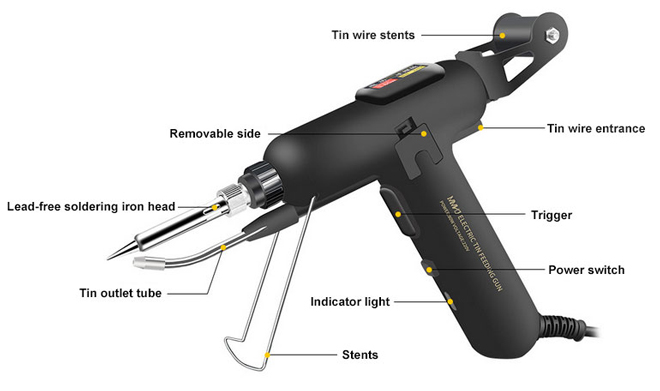What is the Electric Soldering Gun?
An electric soldering gun is an indispensable tool widely used in electronics, electrical work, and DIY projects. This versatile tool provides a reliable and efficient means of joining metal components together using solder, making it an essential asset for professionals and hobbyists alike.
Working Principle
An electric soldering gun is a device used to generate a high temperature electric arc to fuse metal materials together. It works based on the principles of electromagnetic induction and the heat effect.
Specifically, when a soldering gun is energised, it generates high-frequency, low-voltage alternating current (AC). This alternating current is fed into a transformer, and after the step-up and step-down effects of the transformer, a high voltage, low current DC power supply is output. This DC power supply then provides the required electrical energy for welding.
When the automatic soldering gun is switched on, the current passes through the electrode or wire to produce an arc, and generates a high temperature on the surface of the workpiece, causing it to melt and fuse with the electrode or wire. At the same time, in the process of generating the arc, a large amount of heat and gas is produced to protect and clean the welding area.
In addition, in order to ensure the quality and safety of welding, the automatic soldering gun will be equipped with some auxiliary equipment, such as automatic control system, protection device, cooling system and so on.
Key Features and Characteristics
Electric soldering guns are prized for several key features and characteristics:

- Precise Heating: These tools are designed with a heating element that rapidly generates the necessary heat for melting solder. This precision heating ensures accurate soldering and minimizes the risk of overheating or damaging delicate components.
- Temperature Control: Many automatic electric soldering guns come equipped with temperature control settings, allowing users to adjust the heat level according to the specific soldering task. This versatility is crucial when working with different types of solder and materials.
- Quick Warm-Up: One of the standout features of these soldering guns is their rapid warm-up time. Within minutes, they reach the desired operating temperature, reducing downtime and increasing productivity.
- Replaceable Soldering Tips: Electric soldering guns typically feature interchangeable soldering tips or nozzles. These tips come in various shapes and sizes, making it possible to select the most suitable one for a particular job.
- Automatic Solder Feed: Some models incorporate an automatic solder feed mechanism. This innovation eliminates the need for manually applying solder, streamlining the soldering process and ensuring consistent results.
How to Use an Electric Soldering Gun
- Safety First: Before you begin, ensure that you are working in a well-ventilated area and wearing safety glasses to protect your eyes from solder splatter.
- Plug In and Warm Up: Plug the soldering gun into a power source and allow it to warm up. The warm-up time varies depending on the model but is usually quite quick.
- Select the Right Tip: Choose the appropriate soldering tip for your task. Different tips are used for various soldering jobs, such as fine-point tips for small components and chisel tips for larger joints.
- Prepare the Solder: Cut a small length of solder wire and have it ready for use. It's essential to use the right type of solder for your project, typically composed of lead and tin.
- Tin the Tip: To improve heat transfer, "tin" the soldering tip by applying a small amount of solder to it. This helps with heat conduction and ensures proper solder flow.
- Heat the Components: Place the soldering tip in contact with the joint you want to solder. The heat from the tip will melt the solder and create a strong bond between the components.
- Apply Solder: Once the joint is adequately heated, touch the solder wire to the joint. The solder will melt and flow into the joint, creating a secure connection.
- Cool and Inspect: Allow the solder joint to cool naturally. Once cooled, inspect it to ensure a clean and solid connection. Trim any excess solder if necessary.
- Clean the Tip: After each use, clean the soldering tip by wiping it on a damp sponge or tip cleaner. This helps maintain the tip's effectiveness.
- Turn Off and Store: When finished, turn off the soldering gun and unplug it from the power source. Store it in a safe place, making sure the tip is protected.
In summary, electric soldering guns are the soldering tools for professionals and hobbyists involved in electronics, electrical work, and various crafting activities. Understanding their working principle and following proper usage techniques ensures efficient and effective soldering, making it easier to create secure and durable metal connections for a wide range of applications.

